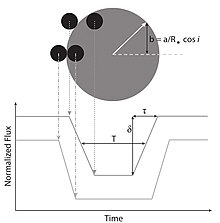User:Astrostudent/sandbox
Adding Citation and Adding Wiki Link
While the radial velocity method provides information about a planet's mass, the photometric method can determine the planet's radius. If a planet crosses (transits) in front of its parent star's disk, then the observed visual brightness of the star drops by a small amount, depending on the relative sizes of the star and the planet.[1] For example, in the case of HD 209458, the star dims by 1.7%. However, most transit signals are considerably smaller; for example, an Earth-size planet transiting a Sun-like star produces a dimming of only 80 parts per million (0.008 percent).
Article Evaluation
- Improvements on the light curve analyzation and what the decrease in flux means in terms of length of transit and location of planet to star.
- Technique section for transit photometry is under-representing on some details that could be useful. It talks about advantages and disadvantages but not so much the actual calculations.
 | This is a user sandbox of Astrostudent. You can use it for testing or practicing edits. This is not the sandbox where you should draft your assigned article for a dashboard.wikiedu.org course. To find the right sandbox for your assignment, visit your Dashboard course page and follow the Sandbox Draft link for your assigned article in the My Articles section. |

- ^ "5 Ways to Find a Planet". exoplanets.nasa.gov. Retrieved 2018-11-20.
